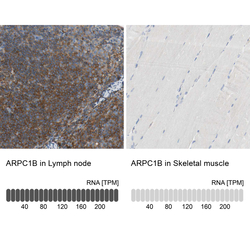Antibody data
- Antibody Data
- Antigen structure
- References [10]
- Comments [0]
- Validations
- Immunohistochemistry [1]
Submit
Validation data
Reference
Comment
Report error
- Product number
- HPA004832 - Provider product page

- Provider
- Atlas Antibodies
- Proper citation
- Atlas Antibodies Cat#HPA004832, RRID:AB_1845044
- Product name
- Anti-ARPC1B
- Antibody type
- Polyclonal
- Description
- Polyclonal Antibody against Human ARPC1B, Gene description: actin related protein 2/3 complex, subunit 1B, 41kDa, Alternative Gene Names: ARC41, p40-ARC, p41-ARC, Validated applications: IHC, WB, Uniprot ID: O15143, Storage: Store at +4°C for short term storage. Long time storage is recommended at -20°C.
- Reactivity
- Human
- Host
- Rabbit
- Conjugate
- Unconjugated
- Isotype
- IgG
- Vial size
- 100 µl
- Concentration
- 0.1 mg/ml
- Storage
- Store at +4°C for short term storage. Long time storage is recommended at -20°C.
- Handling
- The antibody solution should be gently mixed before use.
Submitted references Inherited ARPC5 mutations cause an actinopathy impairing cell motility and disrupting cytokine signaling
ARPC1B Is Associated with Lethal Prostate Cancer and Its Inhibition Decreases Cell Invasion and Migration In Vitro
Neutrophils Require Activation to Express Functional Cell-Surface Complement Receptor Immunoglobulin
ARPC1B binds WASP to control actin polymerization and curtail tonic signaling in B cells
Capping protein regulates endosomal trafficking by controlling F-actin density around endocytic vesicles and recruiting RAB5 effectors
Cortical branched actin determines cell cycle progression
Loss of ARPC1B impairs cytotoxic T lymphocyte maintenance and cytolytic activity
Loss of the Arp2/3 complex component ARPC1B causes platelet abnormalities and predisposes to inflammatory disease
Phosphoproteomic comparison of Pik3ca and Pten signalling identifies the nucleotidase NT5C as a novel AKT substrate
Isoform diversity in the Arp2/3 complex determines actin filament dynamics
Nunes-Santos C, Kuehn H, Boast B, Hwang S, Kuhns D, Stoddard J, Niemela J, Fink D, Pittaluga S, Abu-Asab M, Davies J, Barr V, Kawai T, Delmonte O, Bosticardo M, Garofalo M, Carneiro-Sampaio M, Somech R, Gharagozlou M, Parvaneh N, Samelson L, Fleisher T, Puel A, Notarangelo L, Boisson B, Casanova J, Derfalvi B, Rosenzweig S
Nature Communications 2023;14(1)
Nature Communications 2023;14(1)
ARPC1B Is Associated with Lethal Prostate Cancer and Its Inhibition Decreases Cell Invasion and Migration In Vitro
Gamallat Y, Zaaluk H, Kish E, Abdelsalam R, Liosis K, Ghosh S, Bismar T
International Journal of Molecular Sciences 2022;23(3):1476
International Journal of Molecular Sciences 2022;23(3):1476
Neutrophils Require Activation to Express Functional Cell-Surface Complement Receptor Immunoglobulin
Small A, Perveen K, Putty T, Patel N, Quinn P, Wechalekar M, Hii C, Quach A, Ferrante A
Frontiers in Immunology 2022;13
Frontiers in Immunology 2022;13
ARPC1B binds WASP to control actin polymerization and curtail tonic signaling in B cells
Leung G, Zhou Y, Ostrowski P, Mylvaganam S, Boroumand P, Mulder D, Guo C, Muise A, Freeman S
JCI Insight 2021;6(23)
JCI Insight 2021;6(23)
Capping protein regulates endosomal trafficking by controlling F-actin density around endocytic vesicles and recruiting RAB5 effectors
Yu J, Wei W, Ye Z, Wang D, Huang L, Zhang H, Yue J
eLife 2021;10
eLife 2021;10
Cortical branched actin determines cell cycle progression
Molinie N, Rubtsova S, Fokin A, Visweshwaran S, Rocques N, Polesskaya A, Schnitzler A, Vacher S, Denisov E, Tashireva L, Perelmuter V, Cherdyntseva N, Bièche I, Gautreau A
Cell Research 2019;29(6):432-445
Cell Research 2019;29(6):432-445
Loss of ARPC1B impairs cytotoxic T lymphocyte maintenance and cytolytic activity
Randzavola L, Strege K, Juzans M, Asano Y, Stinchcombe J, Gawden-Bone C, Seaman M, Kuijpers T, Griffiths G
Journal of Clinical Investigation 2019;129(12):5600-5614
Journal of Clinical Investigation 2019;129(12):5600-5614
Loss of the Arp2/3 complex component ARPC1B causes platelet abnormalities and predisposes to inflammatory disease
Kahr W, Pluthero F, Elkadri A, Warner N, Drobac M, Chen C, Lo R, Li L, Li R, Li Q, Thoeni C, Pan J, Leung G, Lara-Corrales I, Murchie R, Cutz E, Laxer R, Upton J, Roifman C, Yeung R, Brumell J, Muise A
Nature Communications 2017;8(1)
Nature Communications 2017;8(1)
Phosphoproteomic comparison of Pik3ca and Pten signalling identifies the nucleotidase NT5C as a novel AKT substrate
Moniz L, Surinova S, Ghazaly E, Velasco L, Haider S, Rodríguez-Prados J, Berenjeno I, Chelala C, Vanhaesebroeck B
Scientific Reports 2017;7(1)
Scientific Reports 2017;7(1)
Isoform diversity in the Arp2/3 complex determines actin filament dynamics
Abella J, Galloni C, Pernier J, Barry D, Kjær S, Carlier M, Way M
Nature Cell Biology 2015;18(1):76-86
Nature Cell Biology 2015;18(1):76-86
No comments: Submit comment
Supportive validation
- Submitted by
- Atlas Antibodies (provider)
- Enhanced method
- Orthogonal validation
- Main image

- Experimental details
- Immunohistochemistry analysis in human lymph node and skeletal muscle tissues using HPA004832 antibody. Corresponding ARPC1B RNA-seq data are presented for the same tissues.
- Sample type
- Human
- Protocol
- Protocol
 Explore
Explore Validate
Validate Learn
Learn Western blot
Western blot Immunohistochemistry
Immunohistochemistry